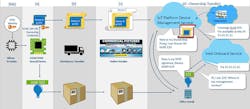Design requirements in the Internet of Things (IoT) space have no doubt become much more sweeping. That’s where Arm’s Pelion IoT Platform steps in—it focuses in on those requirements to help facilitate the creation of safe and secure IoT devices. It’s also designed to help deploy and manage IoT devices.
To make things easier for Arm, it has partnered with a number of companies and organizations to allow the Pelion platform to encompass a widening range of services. Its latest Pelion announcements reflect this course of action.
One of the main new partnerships is with Intel and its Secure Device Onboard (SDO). SDO is an automated service designed to link IoT devices to cloud services like Pelion in a standardized fashion (see figure).
Intel’s Secure Device Onboard (SDO) service uses an Enhanced Privacy ID (EPID) that’s programmed into hardware when a device is created to pair the device with a management service.
Everything starts with a device that’s given an Enhanced Privacy ID (EPID) when created. The EPID is essentially a private crypto key that can be used to generate secure credentials. A device and EPID are paired with a 128-bit globally unique identifier (GUID). GUIDs have been used for a long time to identify everything from an object to a software service. A device’s GUID is effectively its public name, while the EPID stays secret.
Arm platforms now will include the EPID. Some Arb partners were already planning on supporting SDO and including an EPID in their chips. Arm’s Pelion is one of the services supported by SDO.
Another new partner is myDevices. The myDevices platform allows LoRa developers to quickly build long-distance, low-power IoT networks. They can now take advantage of the Pelion management platform as well. Devices built on myDevices’ framework can be handled by the Pelion Device Management System (DMS) for managing and monitoring these devices. This includes myDevices’ IoT in a Box and starter kit.
Arduino developers can also exploit Pelion, although the current news is the ability to tie Arduino-based systems to 2G/3G cellular networks around the world without working with individual service providers. Instead, Arm has done this and will provide companies with SIM cards managed by Pelion’s DMS. Companies would contract with Arm to provide cellular services, enabling devices to then be deployed in different markets. This simplifies billing and management. It can also allow a device to be used in different areas without incurring roaming charges.
Last but definitely not least is Arm’s Mbed Linux OS announcement. The Mbed OS is a lightweight operating system that targets Arm’s Cortex-M microcontrollers. It could run on a Cortex-A platform, but most run other operating systems such as Linux; hence, Mbed Linux. Mbed Linux is a Linux solution that incorporates Mbed functionality, making it possible for platforms to operate as Mbed gateways and tie into the Pelion environment that also manages the Mbed platform.
Mbed Linux is open source; the preview version will be available in November and ship in 2019. It’s complementary to the Mbed OS, and Mbed Linux gateways will be host to numerous Mbed OS devices. Like Mbed, Mbed Linux will be available from Arm with commercial support, including SLAs.
About the Author
William G. Wong
Senior Content Director - Electronic Design and Microwaves & RF
I am Editor of Electronic Design focusing on embedded, software, and systems. As Senior Content Director, I also manage Microwaves & RF and I work with a great team of editors to provide engineers, programmers, developers and technical managers with interesting and useful articles and videos on a regular basis. Check out our free newsletters to see the latest content.
You can send press releases for new products for possible coverage on the website. I am also interested in receiving contributed articles for publishing on our website. Use our template and send to me along with a signed release form.
Check out my blog, AltEmbedded on Electronic Design, as well as his latest articles on this site that are listed below.
You can visit my social media via these links:
- AltEmbedded on Electronic Design
- Bill Wong on Facebook
- @AltEmbedded on Twitter
- Bill Wong on LinkedIn
I earned a Bachelor of Electrical Engineering at the Georgia Institute of Technology and a Masters in Computer Science from Rutgers University. I still do a bit of programming using everything from C and C++ to Rust and Ada/SPARK. I do a bit of PHP programming for Drupal websites. I have posted a few Drupal modules.
I still get a hand on software and electronic hardware. Some of this can be found on our Kit Close-Up video series. You can also see me on many of our TechXchange Talk videos. I am interested in a range of projects from robotics to artificial intelligence.



